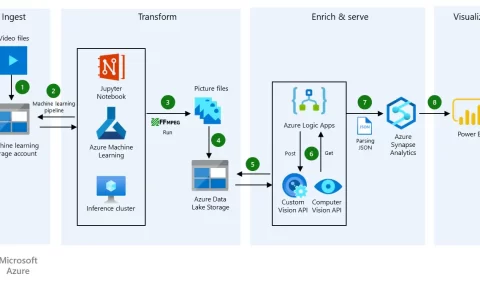Microsoft Visio 2019: Part 2
What you'll learn
55315: Introduction To SQL Databases
What you'll learn
55049-A: PowerPivot, Power View and SharePoint 2013 Business Intelligence Center for Analysts
$1,195.00
55049-A: PowerPivot, Power View and SharePoint 2013 Business Intelligence Center for Analysts
What you'll learn
Microsoft Office Excel (2019-2016-2013): Intermediate
What you'll learn
AI-900T00: Microsoft Azure AI Fundamentals
What you'll learn
Microsoft Office Word 2019: Part 1
What you'll learn
55321: SQL Server Integration Services
What you'll learn
MS-700T00-A: Managing Microsoft Teams
What you'll learn
Microsoft Office Excel (2019-2016-2013): Advanced
What you'll learn
AZ-305T00: Designing Microsoft Azure Infrastructure Solutions
What you'll learn
Microsoft Visio 2019: Part 2
What you'll learn
55315: Introduction To SQL Databases
What you'll learn
55049-A: PowerPivot, Power View and SharePoint 2013 Business Intelligence Center for Analysts
$1,195.00
55049-A: PowerPivot, Power View and SharePoint 2013 Business Intelligence Center for Analysts
What you'll learn
Microsoft Office Excel (2019-2016-2013): Intermediate
What you'll learn
AI-900T00: Microsoft Azure AI Fundamentals
What you'll learn
Microsoft Office Word 2019: Part 1
What you'll learn
55321: SQL Server Integration Services
What you'll learn
MS-700T00-A: Managing Microsoft Teams
What you'll learn
Microsoft Office Excel (2019-2016-2013): Advanced
What you'll learn
AZ-305T00: Designing Microsoft Azure Infrastructure Solutions
What you'll learn
Featured Courses
PL-300: Microsoft Power BI Data Analyst
Course Description: This course will discuss the various methods and …
$1,295.00$1,995.00
PL-300: Microsoft Power BI Data Analyst
55315: Introduction To SQL Databases
Course Description This three-day instructor-led course is aimed at people …
$2,095.00
55315: Introduction To SQL Databases
What you'll learn
55316: Administering A SQL Database
Course Description This instructor-led course provides students who manage SQL …
$2,995.00
55316: Administering A SQL Database
What you'll learn
Microsoft Office Word 2019: Part 3
Course Description: Microsoft® Word enables you to do far more …
$345.00
Microsoft Office Word 2019: Part 3
What you'll learn
Microsoft Office Word 2019: Part 2
Course Description: After you master the basics of creating, editing, …
$345.00
Microsoft Office Word 2019: Part 2
What you'll learn
Microsoft Office Word 2019: Part 1
Course Description: These days, most people take electronic word processing …
$345.00
Microsoft Office Word 2019: Part 1
What you'll learn
Microsoft Office PowerPoint 2019: Part 2
Course Description: Meetings, instruction, training, pitches; these are all a …
$345.00
Microsoft Office PowerPoint 2019: Part 2
What you'll learn
Microsoft Office PowerPoint 2019: Part 1
Course Description: It’s hard to imagine a day going by …
$345.00
Microsoft Office PowerPoint 2019: Part 1
What you'll learn
Microsoft Office Excel (2019-2016-2013): Advanced
Course Description: Clearly, you use Excel a lot in your …
$345.00
Microsoft Office Excel (2019-2016-2013): Advanced
What you'll learn
Microsoft Office Excel (2019-2016-2013): Intermediate
Course Description: Whether you need to crunch numbers for sales, …
$345.00
Microsoft Office Excel (2019-2016-2013): Intermediate
What you'll learn
All Microsoft Courses
Microsoft Online Training Courses - Live
CCS Learning Academy is an official Microsoft Gold partner!
Search here for available courses. If you would like to purchase training for a large group, please contact us for custom pricing. View Certification
Filter by Vendor
AZ-900T00-A:Microsoft Azure Fundamentals Training Certification
Demonstrate Your Fundamental Knowledge Of Cloud Concepts With Azure Our …
$495.00$795.00
What you'll learn
AZ-204T00-A: Developing solutions for Microsoft Azure
Course Description: This course teaches developers how to create end-to-end …
$2,195.00$2,695.00
DP-900T00: Microsoft Azure Data Fundamentals
Course Description: In this course, students will learn the fundamentals …
$495.00$795.00
What you'll learn
AZ-104T00-A: Microsoft Azure Administrator
Course Description: This course teaches IT Professionals how to manage …
$1,795.00$2,295.00
PL-300: Microsoft Power BI Data Analyst
Course Description: This course will discuss the various methods and …
$1,295.00$1,995.00
DP-300T00: Administering Microsoft Azure SQL Solutions
Course Description: This course provides students with the knowledge and …
$2,595.00
What you'll learn
Implementing A SQL Data Warehouse
Course Description This course provides students with the knowledge and …
What you'll learn
55321: SQL Server Integration Services
Course Description This instructor-led course is intended for IT professionals …
$2,995.00























